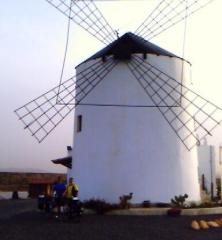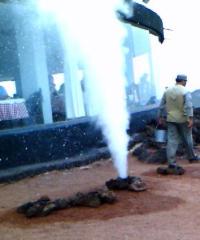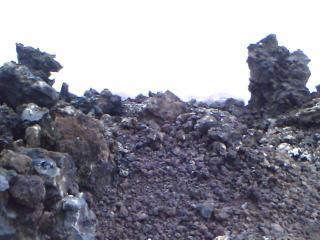

|
Our bed for the night in the middle of Fuerteventura |
Canary Island Hopping
November 15th to 21st 2006 Tinajo on Lanzarote to Antigua Fuerteventura
Home Page
The Route
Week 1
Week 2
Week 3
Week 4
Week 5
Week 6
Week 7
Week 8
Week 9
Week 10
Tandem by Air
Bike and Gear
Navigation and the GPS
Stoker's leg
Links+Downloads
The bike ride started with a purpose. Our host, Chris Furby, said there was a good bike shop only 6km away. It seemed like a good opportunity to replace the chainset broken by the baggage handlers. It was not to be. The shop was certainly up market. Chainsets started at £200 and ordinary cycling tops at £70. Yes, it was good mountain biking country but no, they only stocked road parts, and had no knowledge of anything else. They were an ignorant bunch of unhelpful and ill informed Oz chancers. They don't deserve your business if you come here as well you may because it is a good place for winter training camps.
I suppose some of the above may have been influenced by the fact that we had freewheeled 200m down. We now had the climb back up with nothing to show for it.
On Wednesday we rode up to the Parque National de Timanfaya. The whole of Lanzarote is fashioned by volcanic action. This park is the site of the last (possibly) major eruption on the Canaries. It happened in 1730 and lasted six years, causing enormous havoc and completely changing the landscape and the way people lived on the islands.
As we cycled upwards the landscape began to change. The low white Canarian village houses gave way to well tended farms and vineyards. The fields were all covered in black volcanic ash to retain the little moisture that there was.
After a short rise we came on a rocky plain of almost level solidified lava flow. Here, well landscaped so as not to stand out, is the main visitors centre. Inside there is information well in excess of our need to know. We pedalled on through the eerie scenery to the entrance to Montanas del Fuego. Here for once we had an advantage over the cars. Numbers are controlled at the gate to ensure that facilities at the top are not overcrowded. We went straight to the front of the queue.
The ride up the mountain is an experience in itself. As we climbed the lava field gave way to the steep mountain side covered in a lighter coloured volcanic ash. It had all the feel of a mountain covered in brown snow. It even appeared to have sites of slab avalanches. The silence was also snowlike.
Near the top we passed the rugged tops of volcanoes before arriving at the visitors car park and mountain restaurant. Here it was show time. The car park is constantly full and coaches coming and going. The staff control several holes in the mountain. In one they place some brushwood which soon bursts into flame. In another they pour a bucketful of water which a few seconds later is noisily shot out as steam high into the air. The restaurant, designed by Manrique, cooks over another of these holes with its own grill over and chimney on top. The management was just hoping for a small eruption to disrupt this place which has the feel of the restaurant at the end of the universe.
The only way one is allowed to see the area is by air conditioned coach. Tandems and even walkers are not allowed. We boarded a stinking diesel coach with no off switch for the 14km trip around the mountain roads. It is spectacular but they really do need a rethink. It may have been state of the art 20 years ago but those who still can want to cycle and walk. Those who can't still want to enjoy this superb place close up and as silently as possible. Everyone of the millions who come to Lanzarote come to this place. What an opportunity to show off design and engineering skills.
One highlight of this wonderful day, the hot stones from the ground which were too hot for the stoker to hold. And the odd thing was that there was not even a whiff of sulphur about the place.
 |
This is what happens if you chuck a bucket of water on a volcano |
Day 10 17th November at Tinajo, Lanzarote
We eventually got going out of the village on a backroad heading for the volcanoes. The management had found on the map what he thought was an accessible crater. The stoker was not surprised that it involved 10km on bumpy dirt roads. The vehicles on these roads make corrugations about 50cm apart which jolt every bit of you. Of course some roads have little traffic and fewer corrugations. These are, however, full of rocks and loose sand and scare the stoker. But there are absolutely no puddles.
This road went right through the solidified lava flow. These flows are like rivers of rock within their banks and at the edge normal terrain resumes. And within the flow the surface is more like the Portland Race on a bumpy day than the River Wey. It is not hard to see why Manrique was inspired to build his house in one. Nor how he found the the lava bubbles for his below ground rooms.
With some deft navigation the management got us to the point where the road petered out. Locking the tandem to a bush we took to our feet. The stoker took to her walking pole and we were off up a mule track.
A steep climb and several zig zags later we came to the crater's edge. It was a breathtaking site. The crater is almost a perfect circular bowl, the walls slightly higher to our right. It is about 1km across and 150m deep and the rock sides clear of vegetation. At the very centre a small raised area marks the point of eruption.
We were back in the village by dark and appropriately a look in the diary showed that it was a footsloggers day. That is the day when some perfectly good Dorset cyclists go walking.
Day 11 18th November Tinajo, Lanzarote to Corralejo, Fuerteventura
Another sunny day and the management was keen to get over the hill before the sun got too hot. Everything packed and loaded we manoeuvred the tandem through the garden gate. Chris Furby was there to see us off. He will welcome your email if you are interested in enquiring about a two person studio apartment in his walled garden beside the pool. He has two and they are just as he describes them. They are ideal for cycling and walking with mountains nearby. The local shops are a couple of minutes walk but it is about 6km to the beach.
A pleasant steady climb got us to the rise above the entrance to the volcano park. We stopped to look back over the broad sweep of the north of the island which we had enjoyed so much. We then descended briefly and went into a car park full of camels. The stoker was disappointed that they only went a short distance into the mountain. She had in mind a long trek, though they looked more inclined to generate seasickness than Hobnob. The camels in a previous time had been used to work the land. They were now being used to work the tourists, a much more profitable operation.
We now had the reward for all our climbing, our first long fast mountain descent. Sitting up to slow the bike against the slip stream, the management wondered perhaps a little late whether everything was done up properly. We suppose it is a sign of age but we used to do descents like this without a second thought to our safety. OK, the stoker did sometimes grumble a bit but we survived.
We then came across 15km of the most unusual road system. Two perfectly good parallel roads well maintained and signed but not a dual carriageway. We speculated as to why but came to no conclusion that would satisfy the average British person. We chose the quieter of the two.
We stopped at a view point to look at some salt fields where seawater is evaporated to leave the salt. It seemed an odd thing to do in islands where most of the drinking water comes from the heavily polluting desalination plants. It must be possible to use at least some of the salt rather than pump it back into the sea.
Coming into Playa Blanca where we were to get the ferry to Fuerteventura was something of a shock. We were plunged deep into the world of package holidays, Irish pubs, burger bars and chips with everything. At least the influence of Manrique seems to have prevented high rise buildings.
Avoiding the grockles as best we could we made for the port. It felt real with all the comings and goings. There was even a small group of hippies and a surfer waiting to get on the boat. We didn't feel out of place as we got a brew going on the trangia and had our picnic lunch.
Having delayed the ferry while the stoker bought a ticket for the bike we eventually put to sea. It is a 30 minute crossing to Corralejo on Fuerteventura on a proper car ferry. Whatever Playa Blanca is Corralejo looked more so. Even from a distance the skyline was marked by the many cranes working hard to make it even worse.
Once ashore our worst expectations were realised. On the other hand once having found it our prebooked apartment was fine. Shopping done we were soon 'at home' again.
 |
We cycled through many lava flows on Lanzarote |
Days 12, 13 and 14 19th to 21st November Corralejo to Antigua, Fuerteventura
We had a sort of day off though we did walk a long way. We eventually even found the the shops the Spanish used but not until we had already been ripped off by Netto. The Netto supermarket bill was so high that the management paid by credit card which needed supplementary identification. As the stoker was looking after his passport he instead proffered his Dorset bus pass which was found to be perfectly acceptable.
The management even went in for a swim though those in the UK need not be too envious. The water temperature is only around 20 degrees which is not exactly balmy.
Moving islands here is not unlike changing countries on our other tours. Fuerteventura is physically very different from Lanzarote. Many of the beaches have white sand and even the volcanic areas were not nearly as rugged and black.
As we got going on our cycle ride to Antigua fully loaded the cultural differences also became clear. Their lack of an Manrique to keep them sensible seriously damages the quality of life. Crane city extends at least 5km out of Corralejo. It generates heavy lorry traffic on the roads and despoils the countryside. There is not even the odd roadie cyclist here and few people walk. The tiny silent villages of 20 years ago are now merging into an urban waste land.
Eventually after about 20km we turned off at the top of a long climb onto a quiet road. Civilisation returned though it was a very hot close day and the stoker in particular was feeling the heat. We even found a village just like those of 20 years ago. Nothing moved and the only sound was the rattle of a badly fitted street sign in the wind. We stopped for lunch out of the sun in a bus shelter, the roof of which was made of bamboo matting. All buses seemed long gone.
Even though this is a relatively flat island we still climbed to about 320m from sea level and did total ascents of just under 500m. So we were both quite tired when we approached the windmill pictured at the top of this page. It had been a job to find any accommodation half way down Fuerteventura. To find such a nice place was a special bonus. John and Lesley welcomed us with John cooking an excellent veggie meal. Interestingly the mill is not a renovation but a new construction. It meets the regulations as an agricultural building and the sails will grind corn. They are connected via a vehicle differential to a converted hand driven corn grinder. And this is in our bedroom. John has also planted several hectares of aloe vera plants. He is officially a farmer but mainly a Mr Fixit for the local British population and those considering moving here.
Having stayed up late chatting and breakfasted late we decided to have an easy day mooching around on the tandem. We had a long lazy lunch and looked at the local tourist windmill comparing it to ours.
As a final gesture at the end of the second week we decided to post all our camping stuff home. The box with it all in measures about 50cm by 50cm by 25cm and weighs about 15kg. If we can't find a hotel where we pitch up in future then we will wave a credit card at a taxi to take us to one.
Home Page
The Route
Week 1
Week 2
Week 3
Week 4
Week 5
Week 6
Week 7
Week 8
Week 9
Week 10
Tandem by Air
Bike and Gear
Navigation and the GPS
Stoker's leg
Links+Downloads
This site is created and maintained by Anne Neale and Ken Reed.